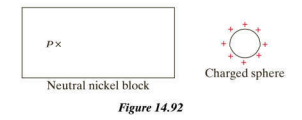You place a neutral block of nickel near a small glass sphere that has a charge of uniformly distributed over its surface, as shown in Figure 14.92.

![]()
(a) About how long do you have to wait to make sure that the mobile electron sea inside the nickel block has reached equilibrium? (1) Less than a nanosecond , (2) Several hours, (3) About , (4) About (b) In equilibrium, what is the average drift speed of the mobile electrons inside the nickel block? (1) About , (2) About , (3) (c) In the equation , what is the meaning of the symbol ? (1) The density of mobile electrons inside the metal, in localid="1657175774793" , (2) The mobility of an electron inside the metal, in , (3) The time it takes a block of metal to reach equilibrium, in seconds



